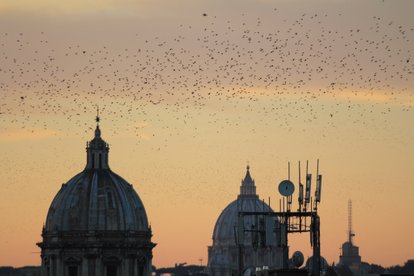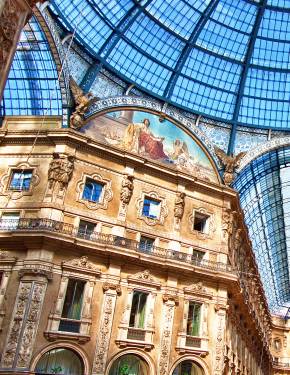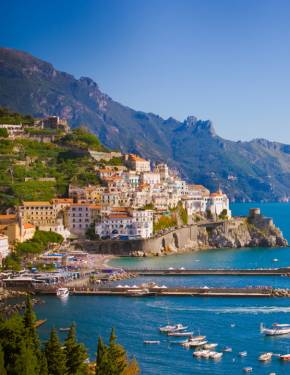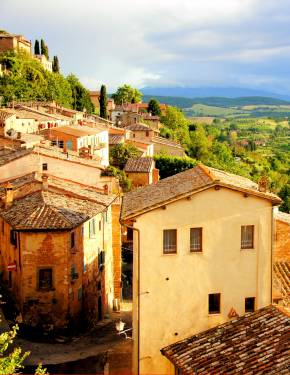Starling Murmuration in Rome 2025-2026
A few millions of birds over the city—a fanciful natural phenomenon to observe, and also a poopocalypse for the city's utility services
Best time: November–February
While Rome is a prime destination among tourists to its historic sights and exquisite architecture, it also attracts millions of starlings, small birds, which tend to flock in huge groups. Drawn by the city's mild climate, the starlings are mainly known for the phenomenon of starling murmuration, during which thousands of birds soar into the sky. Although the sight is magnificent, the murmuration proves to be challenging for city's infrastructure and utilities due to large amount of droppings.
Murmuration Process
Rising up from their roosting site, starlings come together in a huge cloud of flapping wings, spreading over the sky above. The birds seem to anticipate each other's movement and move in different directions, creating various swirling shapes. Their motions seem synchronized and uniform, mainly due to birds following the scale-free correlation, aligning themselves with seven other birds and coordinating their flight with them. The flock continues its performance for approximately 45 minutes or even an hour. Back in ancient Rome, the starling murmuration was examined by Roman augurs for signs from the gods.
Reasons Why Birds Swarm
To explain this mesmerizing phenomenon, scientists produced several theories. The main reason why starlings group together is to protect themselves from predators, namely falcons and hawks. The intimidating shapes of murmuration are also said to scare away predators. However, there have been reported cases when the bird is separated from the flock and immediately attacked by the carnivorous bird, meaning that the sheer size of the flock doesn't intimidate other birds. Another theory is that starlings huddle together for warmth and perform murmuration as their pre-roosting ritual, calling other starlings to join them.
Best Time to See Starling Murmuration
This pre-roosting performance takes place between November and December, and remains one of the world's greatest natural phenomena. During colder months, starlings flock together for warmth and company, roosting in sheltered spots, including forests, cliffs, and most notably, buildings and city infrastructure. Although during the peak of murmuration, Rome is filled to the brim with starlings, most of them depart to their breeding grounds in Scandinavia, leaving only a small population of birds behind.
Drawbacks of Starling Murmuration
The fact that from around a million to 5 millions of starlings choose the city of Rome as their wintering ground might appear seem like a blessing, but the phenomenon has its downside. Seeing such an impressive birds' congregation hurling in unison over Roman domes is breathtaking, but it's important to remember that birds also have their natural needs. After each starling murmuration, the city streets are covered in tons of starlings' droppings. Not only unpleasant, but also dangerous, birds' poop corrodes monuments and causes roads to turn slippery, leadings to accidents. These challenges would be far more bearable if the birds stopped its flocking for a short period, but the phenomenon spans throughout the entire winter, and sometimes even longer. To some Romans, the starlings' visit is, to be honest, unwanted.
City's Measures & Precautions
It might seem surprising, but the city's authorities usually implement the so-called bird-scaring measures to reduce the number of avian visitors. In particular, utility workers place artificial falcons and sonic birds on the trees along Tiber river, known to be starlings' roosting place. After the sunset, teams of environmental department workers, armed with bullhorns, spill out onto the streets of Rome to redirect starlings to green spaces, away from urban areas. The workers play distressed calls of starlings and flash lights to scare the birds. The main goal is to split a large group into several, more managable groups.
Places to See Starlings Murmurate in Rome
A popular watching place is Piazza dei Cinquecento near Termini station, but throughout winter the birds manage to scatter around the entire city. An umbrella might be of great use. Esquilino area, spanning around the Termini station is another great choice, additionally offering numerous budget accommodation options and a number of Asian restaurants. Starlings also are known to hang out near River Tiber, so consider stopping by Ponte Sisto bridge, which offers some of the best views of the spectacle.















































































